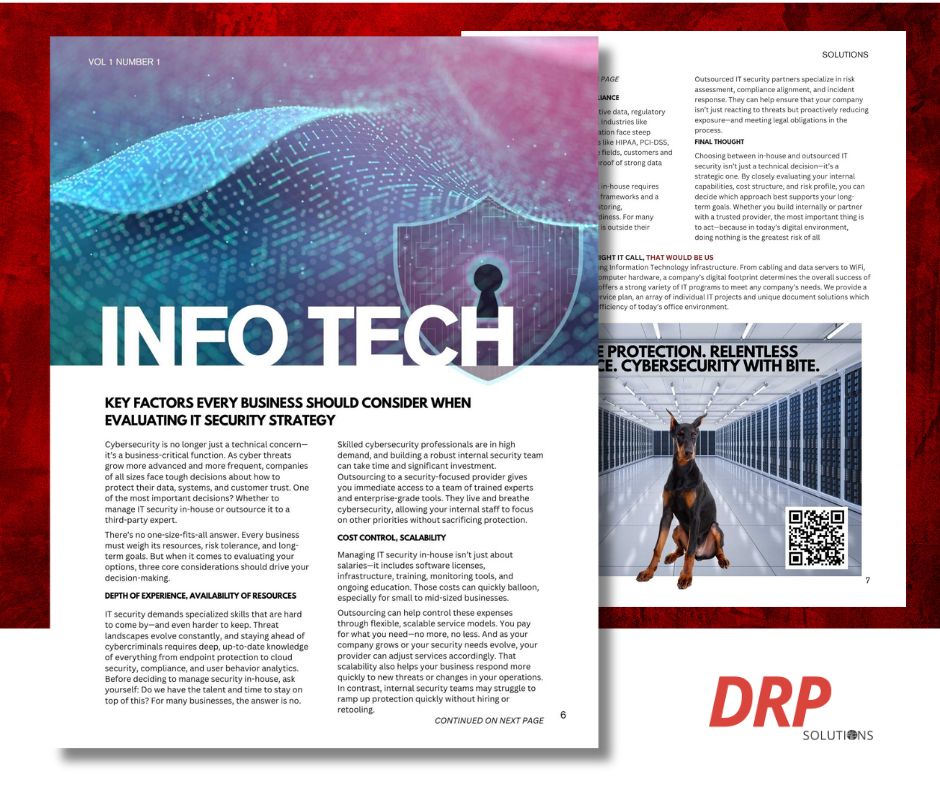Cybersecurity is no longer just a technical concern—it’s a business-critical function. As cyber threats grow more advanced and more frequent, companies of all sizes face tough decisions about how to protect their data, systems, and customer trust. One of the most important decisions? Whether to manage IT security in-house or outsource it to a third-party expert.
There’s no one-size-fits-all answer. Every business must weigh its resources, risk tolerance, and long-term goals. But when it comes to evaluating your options, three core considerations should drive your decision-making.
Depth of Experience, Availaility of Resources
IT security demands specialized skills that are hard to come by—and even harder to keep. Threat landscapes evolve constantly, and staying ahead of cybercriminals requires deep, up-to-date knowledge of everything from endpoint protection to cloud security, compliance, and user behavior analytics.
Before deciding to manage security in-house, ask yourself: Do we have the talent and time to stay on top of this? For many businesses, the answer is no.
Skilled cybersecurity professionals are in high demand, and building a robust internal security team can take time and significant investment.
Outsourcing to a security-focused provider gives you immediate access to a team of trained experts and enterprise-grade tools. They live and breathe cybersecurity, allowing your internal staff to focus on other priorities without sacrificing protection.
Cost Control, Scalability
Managing IT security in-house isn’t just about salaries—it includes software licenses, infrastructure, training, monitoring tools, and ongoing education. Those costs can quickly balloon, especially for small to mid-sized businesses.
Outsourcing can help control these expenses through flexible, scalable service models. You pay for what you need—no more, no less. And as your company grows or your security needs evolve, your provider can adjust services accordingly. That scalability also helps your business respond more quickly to new threats or changes in your operations. In contrast, internal security teams may struggle to ramp up protection quickly without hiring or retooling.
Risk Management and Compliance
If your business handles sensitive data, regulatory compliance is non-negotiable. Industries like healthcare, finance, and education face steep penalties for violations of laws like HIPAA, PCI-DSS, and GDPR. Even outside those fields, customers and partners increasingly expect proof of strong data protection practices.
Managing compliance and risk in-house requires deep knowledge of regulatory frameworks and a commitment to constant monitoring, documentation, and audit readiness. For many businesses, this level of effort is outside their wheelhouse.
Outsourced IT security partners specialize in risk assessment, compliance alignment, and incident response. They can help ensure that your company isn’t just reacting to threats but proactively reducing exposure—and meeting legal obligations in the process.
Final Thought
Choosing between in-house and outsourced IT security isn’t just a technical decision—it’s a strategic one. By closely evaluating your internal capabilities, cost structure, and risk profile, you can decide which approach best supports your long-term goals. Whether you build internally or partner with a trusted provider, the most important thing is to act—because in today’s digital environment, doing nothing is the greatest risk of all
IF YOU WANT TO MAKE THE RIGHT IT CALL, THAT WOULD BE US
Every business relies on a strong Information Technology infrastructure. From cabling and data servers to WiFi, cybersecurity, software and computer hardware, a company’s digital footprint determines the overall success of its employees. DRP Solutions offers a strong variety of IT programs to meet any company’s needs. We provide a comprehensive Managed IT service plan, an array of individual IT projects and unique document solutions which all improve the function and efficiency of today’s office environment.

